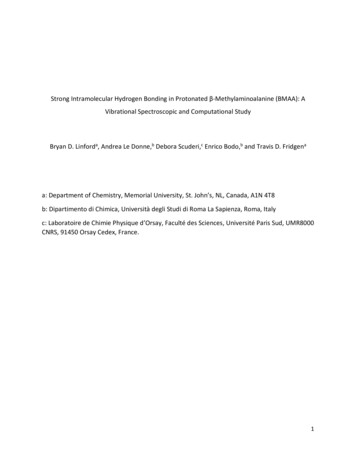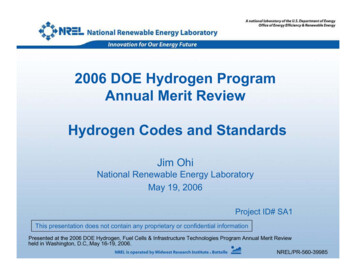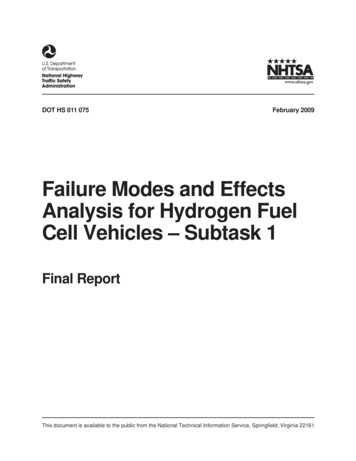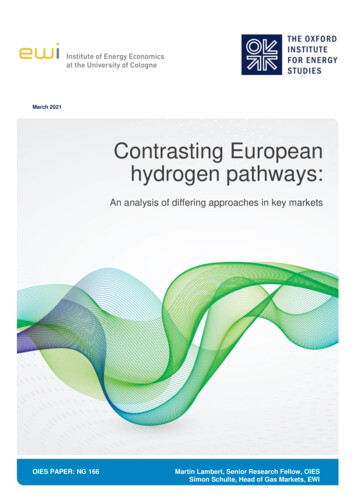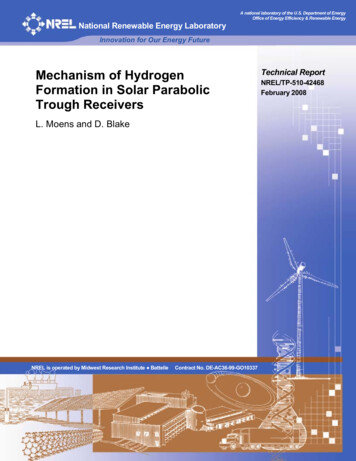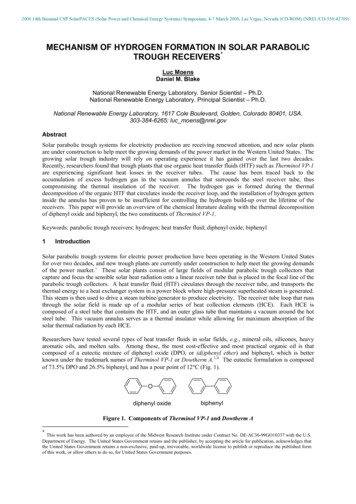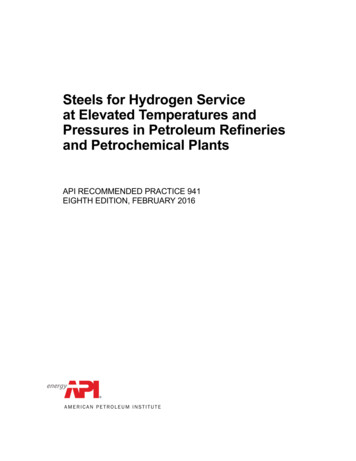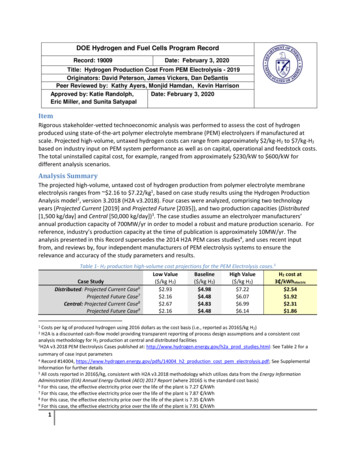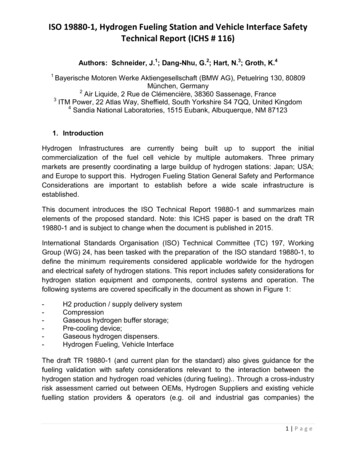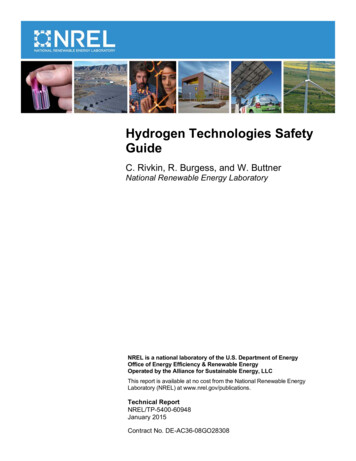
Transcription
Hydrogen Technologies SafetyGuideC. Rivkin, R. Burgess, and W. ButtnerNational Renewable Energy LaboratoryNREL is a national laboratory of the U.S. Department of EnergyOffice of Energy Efficiency & Renewable EnergyOperated by the Alliance for Sustainable Energy, LLCThis report is available at no cost from the National Renewable EnergyLaboratory (NREL) at www.nrel.gov/publications.Technical ReportNREL/TP-5400-60948January 2015Contract No. DE-AC36-08GO28308
Hydrogen Technologies SafetyGuideC. Rivkin, R. Burgess, and W. ButtnerNational Renewable Energy LaboratoryPrepared under Task No. HT12.7310NREL is a national laboratory of the U.S. Department of EnergyOffice of Energy Efficiency & Renewable EnergyOperated by the Alliance for Sustainable Energy, LLCThis report is available at no cost from the National Renewable EnergyLaboratory (NREL) at www.nrel.gov/publications.National Renewable Energy Laboratory15013 Denver West ParkwayGolden, CO 80401303-275-3000 www.nrel.govTechnical ReportNREL/TP-5400-60948January 2015Contract No. DE-AC36-08GO28308
NOTICEThis report was prepared as an account of work sponsored by an agency of the United States government.Neither the United States government nor any agency thereof, nor any of their employees, makes any warranty,express or implied, or assumes any legal liability or responsibility for the accuracy, completeness, or usefulness ofany information, apparatus, product, or process disclosed, or represents that its use would not infringe privatelyowned rights. Reference herein to any specific commercial product, process, or service by trade name,trademark, manufacturer, or otherwise does not necessarily constitute or imply its endorsement, recommendation,or favoring by the United States government or any agency thereof. The views and opinions of authorsexpressed herein do not necessarily state or reflect those of the United States government or any agency thereof.This report is available at no cost from the National Renewable EnergyLaboratory (NREL) at www.nrel.gov/publications.Available electronically at http://www.osti.gov/scitechAvailable for a processing fee to U.S. Department of Energyand its contractors, in paper, from:U.S. Department of EnergyOffice of Scientific and Technical InformationP.O. Box 62Oak Ridge, TN 37831-0062phone: 865.576.8401fax: 865.576.5728email: mailto:reports@adonis.osti.govAvailable for sale to the public, in paper, from:U.S. Department of CommerceNational Technical Information Service5285 Port Royal RoadSpringfield, VA 22161phone: 800.553.6847fax: 703.605.6900email: orders@ntis.fedworld.govonline ordering: http://www.ntis.gov/help/ordermethods.aspxCover Photos: (left to right) photo by Pat Corkery, NREL 16416, photo from SunEdison, NREL 17423, photo by Pat Corkery, NREL16560, photo by Dennis Schroeder, NREL 17613, photo by Dean Armstrong, NREL 17436, photo by Pat Corkery, NREL 17721.NREL prints on paper that contains recycled content.
List of y having jurisdictionAmerican National Standards InstituteAmerican Society of MaterialsAmerican Society of Mechanical EngineersAmerican Society of Testing Materialsboiler and pressure vesselCalifornia Fire CodeCode of Federal RegulationsCompressed Gas AssociationCanadian Standards AssociationU.S. Department of TransportationU.S. Environmental Protection Agencyhydrogenhydrogen gas vehicleInternational Building CodeInternational Fire CodeInternational Fuel Gas CodeInternational Mechanical CodeNational Fire Protection AssociationNational Institute of Standards and TechnologyNational Renewable Energy LaboratoryOccupational Safety and Health Administrationproton exchange membraneprocess hazard analysisSociety of Automotive EngineersUnderwriters LaboratoriesiiiThis report is available at no cost from the National Renewable Energy Laboratory (NREL) at www.nrel.gov/publications.
Table of ContentsList of Figures . vList of Tables . vIntroduction . 1General Safety Issues and Physical Properties of Hydrogen . 3History of Hydrogen Technologies . 8Discovery of Hydrogen . 8Hydrogen Use and Applications. 8Glass Manufacturing . 8Industrial Heat Transfer Fluid . 9Semiconductor Manufacturing. 9Ammonia Production via the Haber-Bosch Process . 9Hydrogen in the Petrochemical Industry . 9Hydrogen as a Fuel for Fuel Cells . 10Hydrogen Safety Incidents . 10Regulations, Codes, and Standards . 12Material Selection for Hydrogen Technologies. 27Component Selection for Hydrogen Technologies . 29The Permitting Process . 31The Permit Applicant . 33Permit Template and Example Permit . 34Template—Hydrogen Dispenser Added to Existing Fueling Station . 34Example Permit. 57References . 61Informational Websites. 62Appendix A. NREL Process Hazard Analysis on a Representative Hydrogen Fueling Station . 63ivThis report is available at no cost from the National Renewable Energy Laboratory (NREL) at www.nrel.gov/publications.
List of FiguresFigure 1. Timeline of codes and standards development and the codes and standards hierarchy 13Figure 2. Schematic of a typical hydrogen dispensing station with single dispenser with gaseousand liquid hydrogen storage . 60Figure A-1. Schematic of a representative hydrogen station . 63Figure A-2. NREL risk matrix . 65List of TablesTable 1. Comparison of Total Vehicles and Fuel Consumed by Alternative Fuel Type. 2Table 2. Hydrogen Properties . 4Table 3. DOT Hazard Classification Scheme . 5Table 4. Overview of Regulations, Codes, and Standards Related to Hydrogen InfrastructureSafety . 14Table 5. Hydrogen Dispensing Station Permitting/Potential Permits Required . 32Table 6. Hydrogen Dispensing Station Approvals . 32Table A-1. Risk Value Frequencies . 64Table A-2. NREL Event Probability Classification Table. 66Table A-3. Total Risk at Node . 67vThis report is available at no cost from the National Renewable Energy Laboratory (NREL) at www.nrel.gov/publications.
IntroductionThe purpose of this guide is to provide basic background information on hydrogen technologies.It is not intended to be a comprehensive collection of hydrogen technologies safety information.It is intended to provide project developers, code officials, and other interested parties thebackground information to be able to put hydrogen safety in context. For example, code officialsreviewing permit applications for hydrogen projects will get an understanding of the industrialhistory of hydrogen, basic safety concerns, and safety requirements.What are hydrogen technologies? For the purposes of this report they are processes that use orproduce hydrogen. Hydrogen can be used as fuel to power internal combustion engines or fuelcells, or as an energy carrier. Hydrogen has been used as an industrial chemical for more than acentury. The Haber process for producing ammonia was developed in 1909 (Austin 1984), andthe production of ammonia accounts for approximately half of the hydrogen produced worldwide(Ramachandran and Menon 1998). Approximately 40% of hydrogen produced is used tohydrogenate petroleum products. Hydrogen is also used in several industrial processes includingthe following: Glass production Electronics manufacturing Coolant applications (low viscosity and high heat transfer) (Austin 1984).Safety requirements for industrial uses of hydrogen are relatively well established. The NationalFire Protection Association (NFPA) and the Compressed Gas Association (CGA) have publishedsafety standards that address the storage, use, and handling of hydrogen in industrial applicationsthat date back to the first edition of NFPA 567 (later renumbered as NFPA 50A) (National FireProtection Association 1963) circa 1960.In the last 20 years there has been a developing interest in using hydrogen as a fuel for fuel cells,primarily proton exchange membrane (PEM) fuel cells. PEM fuel cells are the preferred fuel celltechnology for vehicles and other new applications because of their fast start-up time and lowoperating temperature. These fuel cells are used for stationary power, primarily in backup powerunits, and to produce electricity for electric vehicles. Hydrogen fuel cell vehicles require fuelingat intervals comparable to a gasoline powered vehicle. This fueling activity will likely requirevehicle owners and operators to operate fueling equipment, although in some states all fueling isconducted by fueling station personnel. Fueling a hydrogen fuel cell vehicle requiresapproximately five minutes. This exposure of the general public to hydrogen represents asignificant change in the hydrogen risk spectrum from that of trained workers in a controlledenvironment handling hydrogen.Placing hydrogen at public fueling stations and using it in vehicles has created a need for newsafety requirements. These requirements reside in several documents and are addressed in theRegulations, Codes, and Standards section of this document.This document is organized into the following seven sections: Introduction1This report is available at no cost from the National Renewable Energy Laboratory (NREL) at www.nrel.gov/publications.
Physical properties of hydrogen History of hydrogen technologies Overview of regulations, codes, and standards for hydrogen technologies Material selection for hydrogen technologies Component selection for hydrogen technologies Overview of permitting hydrogen technologies.Table 1 (U.S. Census Bureau 2012) shows that approximately 174,000 gasoline equivalentgallons of hydrogen were consumed in 2011. This is well under 1% of the total alternative fuelsconsumed in that year. However, this number should increase as zero-emission-vehicle mandatesdrive increased usage of fuel cell vehicles. This table shows that hydrogen fuel cell vehicles arein the developmental phase. Each year has shown an increase in the number of vehicles and theamount of fuel consumed, but the totals are very small relative to other alternative fuels.Table 1. Comparison of Total Vehicles and Fuel Consumed by Alternative Fuel TypeFuel 2976
Fire Protection Association (NFPA) and the Compressed Gas Association (CGA) have published safety standards that address the storage, use, and handling of hydrogen in industrial applications that date back to the first edition of NFPA 567 (later renumbered as NFPA 50A) (National Fire Protection Association 1963) circa 1960. In the last 20 years there has been a developing interest in using .Cited by: 5Publish Year: 2015Author: Carl H. Rivkin, Robert M. Burgess, William J. Buttner


